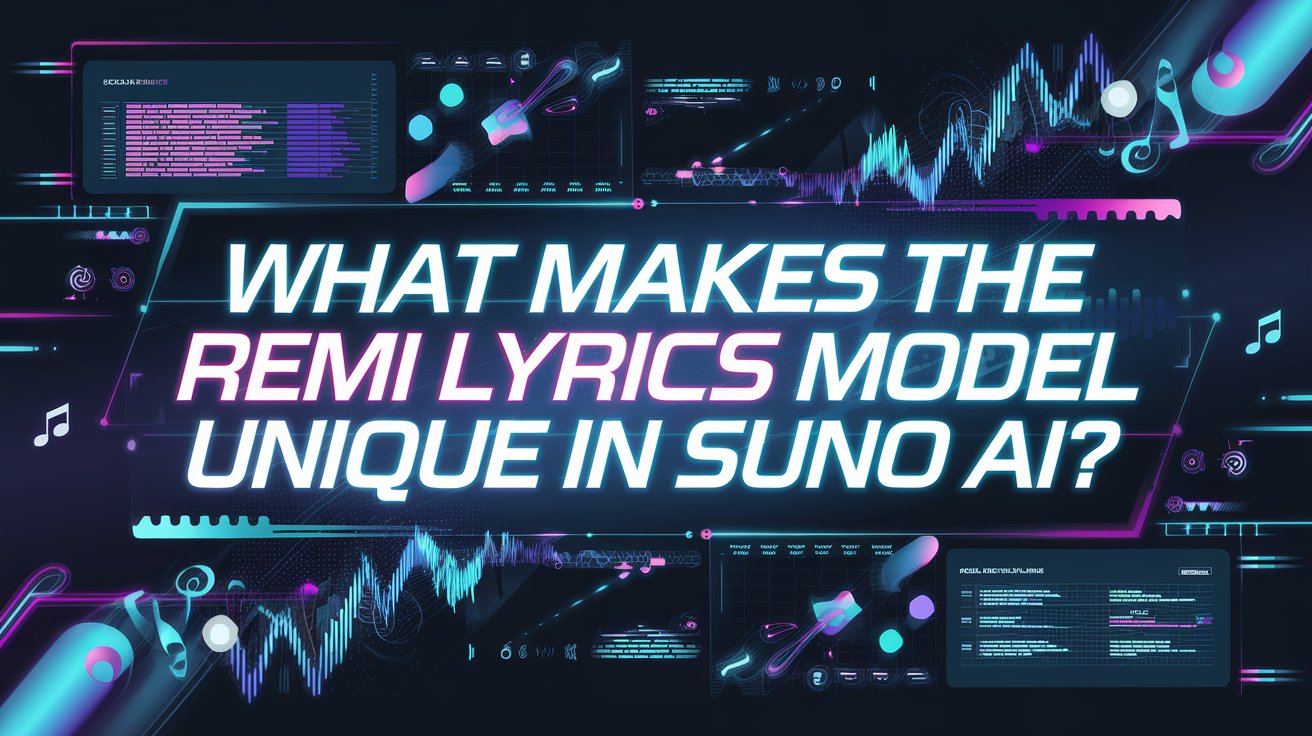Suno AI’s ReMi lyrics model represents a significant leap in AI-assisted songwriting, blending technical innovation with creative flexibility. Integrated into Suno V4, ReMi distinguishes itself through enhanced lyric quality, genre adaptability, and seamless collaboration with other music generation tools. Let’s break down what sets this system apart.
Core Innovations in ReMi’s Lyric Generation
ReMi introduces three key advancements that reshape how lyrics are created:
- Edgier, More Nuanced Output
Unlike earlier models, ReMi prioritizes lyrical boldness and emotional resonance. Users report fewer generic phrases and more vivid storytelling, with improvements in:- Rhyme Complexity: Moves beyond simple AABB patterns to incorporate internal rhymes and slant rhymes.
- Narrative Flow: Maintains thematic consistency across verses and choruses.
- Emotional Range: Generates lyrics spanning from introspective ballads to aggressive rap verses.
- Dual-Model Flexibility
Suno V4 lets creators toggle between ReMi and the Classic model, offering distinct creative pathways: Feature ReMi Model Classic Model Tone Bold, experimental Familiar, radio-friendly Rhyme Style Complex, unpredictable Traditional, structured Best For Genre-pushing tracks Mainstream adaptations This dual approach allows artists to match lyrics to their project’s vision. - Context-Aware Music Pairing
ReMi doesn’t work in isolation—it dynamically adapts lyrics to Suno’s AI-generated instrumentation. For example:- Upbeat synth melodies trigger more energetic, percussive word choices
- Minor-key ballads prompt introspective lyricism
- Genre tags like “punk” or “R&B” alter both vocabulary and vocal delivery styles
How ReMi Enhances Creative Workflows
Accessing ReMi’s capabilities involves a streamlined process:
- Enable Custom Mode in Suno’s interface
- Click Write with Suno in the lyrics section
- Describe your desired theme/style (e.g., “breakup song with nautical metaphors”)
- Select ReMi from the model dropdown
Real-World Example:
A user prompting “cyberpunk rebellion anthem” received:
“Neon veins pulse through concrete skin,
We jack in where the law can’t begin—
Firewalls crack as our chorus begins,
Tonight we reboot where the future’s been.”
This output demonstrates ReMi’s ability to merge genre-specific imagery with rhythmically tight structures.
Technical Backbone: What Powers ReMi
Three technical breakthroughs enable ReMi’s performance:
- Cross-Modal Training
The model was trained on paired lyric-instrumental datasets, allowing it to understand how words interact with musical elements like tempo and key changes. - Feedback-Driven Iteration
Suno incorporated 18 months of user feedback into ReMi’s design, specifically addressing:- Overused clichés in love songs
- Inconsistent point-of-view shifts
- Weak bridge sections
- Ethical Safeguards
While embracing edgier content, ReMi implements:- Real-time content moderation filters
- User-adjustable “boldness” sliders (in development)
- Transparency logs explaining lyric rejections
Comparative Advantages Over Alternatives
ReMi outperforms general-purpose AI tools in music-specific contexts:
| Task | ReMi (Suno V4) | Generic AI (e.g., ChatGPT) |
|---|---|---|
| Verse-Chorus Contrast | Builds dynamic tension | Often repetitive |
| Syllable Matching | Aligns with vocal rhythms | Ignores musical timing |
| Genre Adaptation | Adjusts slang/imagery | Generic across styles |
| Collaborative Editing | Syncs with track changes | Manual integration needed |
Musicians particularly praise ReMi’s grasp of musical timing—lyrics automatically adapt when users modify a track’s BPM or time signature.
Limitations and Future Directions
Early adopters note areas for improvement:
- No Iterative Editing: Can’t tweak individual lines without regenerating entire lyrics
- Niche Genre Gaps: Struggles with highly specific styles like Gregorian chants
- Multilingual Support: Currently optimized for English, with other languages in beta
Suno’s roadmap suggests upcoming features like duet mode (auto-generated counterpoint lyrics) and metaphor engines that extend conceptual frameworks across full albums.
Conclusion: Redefining Collaborative Songwriting
ReMi doesn’t just generate lyrics—it acts as a tireless co-writer that understands musical context. By combining stylistic boldness with technical precision, it empowers artists to explore territories they might avoid when writing alone. As one beta tester noted: “It’s like having a co-writer who’s listened to every song ever made, but still lets you steer the creative ship.”
While not replacing human creativity, ReMi removes logistical barriers, letting musicians focus on high-concept ideas while handling the intricate marriage of words and music. As Suno continues refining these tools, the line between human and AI collaboration in music grows increasingly seamless.



